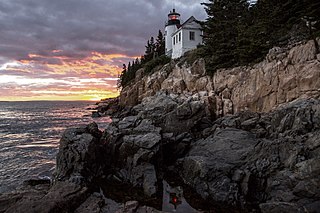
Acadia National Park is an American national park located along the mid-section of the Maine coast, southwest of Bar Harbor. The park includes about half of Mount Desert Island, part of the Isle au Haut, the tip of the Schoodic Peninsula, and portions of sixteen smaller outlying islands.
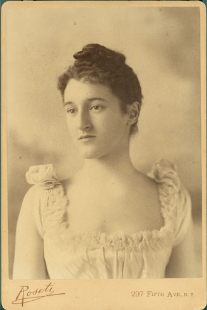
Beatrix Cadwalader Farrand was an American landscape gardener and landscape architect. Her career included commissions to design about 110 gardens for private residences, estates and country homes, public parks, botanic gardens, college campuses, and the White House. Only a few of her major works survive: Dumbarton Oaks in Washington, D.C., the Abby Aldrich Rockefeller Garden on Mount Desert, Maine, the restored Farm House Garden in Bar Harbor, the Peggy Rockefeller Rose Garden at the New York Botanical Garden, and elements of the campuses of Princeton, Yale, and Occidental.

Bar Harbor is a resort town on Mount Desert Island in Hancock County, Maine, United States. As of the 2020 census, its population is 5,089. The town is home to the College of the Atlantic, Jackson Laboratory, and MDI Biological Laboratory. During the summer and fall seasons, it is a popular tourist destination.

Mount Desert Island in Hancock County, Maine, is the largest island off the coast of Maine. With an area of 108 square miles (280 km2) it is the 52nd-largest island in the United States, the sixth-largest island in the contiguous United States, and the second-largest island on the Eastern Seaboard, behind Long Island and ahead of Martha's Vineyard. According to the 2010 census, the island has a year-round population of 10,615. In 2017, an estimated 3.5 million tourists visited Acadia National Park on MDI. The island is home to numerous well-known summer colonies such as Northeast Harbor and Bar Harbor.

Robert Abbe was an American surgeon and pioneer radiologist in New York City. He was born in New York City and educated at the College of the City of New York and Columbia University.

Cadillac Mountain is located on Mount Desert Island, within Acadia National Park, in the U.S. state of Maine. With an elevation of 1,530 feet, its summit is the highest point in Hancock County and the highest within 25 miles (40 km) of the Atlantic shoreline of the North American continent between the Cape Breton Highlands, Nova Scotia, and peaks in Mexico. It is known as the first place in the continental U.S. to see the sunrise, although that is only true for a portion of the year.
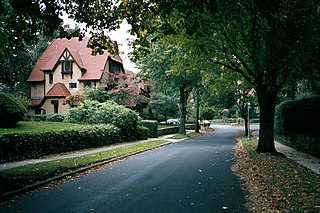
Grosvenor Atterbury was an American architect, urban planner and writer. He studied at Yale University, where he was an editor of campus humor magazine The Yale Record After travelling in Europe, he studied architecture at Columbia University and worked in the offices of McKim, Mead & White.
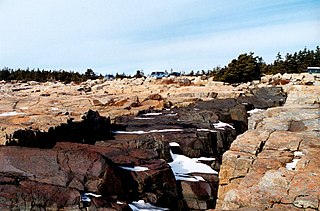
The Schoodic Peninsula is a peninsula in Down East Maine. It is located four miles (6 km) east of Bar Harbor, Maine, as the crow flies. The Schoodic Peninsula contains 2,266 acres (9 km2), or approximately 5% of Acadia National Park. It includes the towns of Gouldsboro and Winter Harbor. The peninsula has a rocky granite shoreline containing many volcanic dikes. The peninsula is home to the former United States Navy base, NSGA Winter Harbor, which has been converted into a National Park Service training center. A 3,300-acre (13 km2) resort development was proposed for land abutting Schoodic Peninsula's national park holdings to the north. An anonymous donor eventually bought the entire 3,200-acre tract and built the Schoodic Woods Campground and miles of gravel bike paths before donating all of it to Acadia National Park. Opening in 2015, Schoodic Woods is the newest campground in Acadia National Park, and the first built in the park since the original campgrounds were built by the Civilian Conservation Corps during the Great Depression beginning in 1936. In the summer, the Schoodic peninsula is currently served by two separate ferry services from Bar Harbor to Winter Harbor that run daily.

Sutton Island, in Hancock County, Maine, United States, is a small, private island south of Mount Desert Island, and north of Cranberry Isles. Its dimensions are roughly 2.1 km on its east–west axis by 1.1 km north to south.

William Ralph Emerson was an American architect. He partnered with Carl Fehmer in Emerson and Fehmer.

Jordan Pond is an oligotrophic tarn in Acadia National Park near the town of Bar Harbor, Maine. The pond covers 187 acres (76 ha) to a maximum depth of 150 feet (46 m) with a shoreline of 3.6 miles (5.8 km).
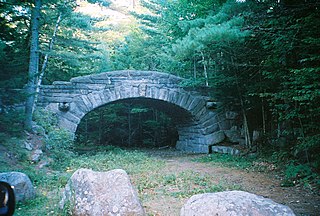
Acadia National Park, largely on Mount Desert Island, off the coast of the U.S. state of Maine, was created in part by land and other donations by John D. Rockefeller Jr. Between 1919 and 1931, Rockefeller, who was opposed to the introduction of automobiles on the island, personally oversaw the construction of a network of carriage roads, closed to motorized vehicles, on the eastern half of the island, including sixteen granite bridges and two gatehouses. The major portion of this network now falls within the bounds of the national park, and was listed on the National Register of Historic Places in 1979.

Naval Security Group Activity, Winter Harbor was a radio station of the United States Navy that operated from 1935 to 2002.

Somesville is the oldest village of the town of Mount Desert on Mount Desert Island in southeastern Maine, United States. It is located on the north end of Somes Sound. The village was established by Abraham Somes who was the first European settler on the island. It attracted many people because of its mills and quarries. The entire village is part of the Somesville Historic District.
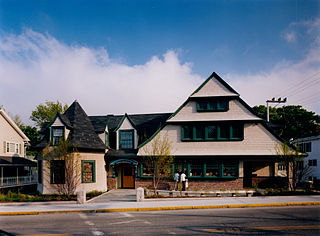
The Abbe Museum is a museum with two locations in Bar Harbor, Maine, on Mount Desert Island. The museum is dedicated to exploring the history and culture of Maine's Native people, the Wabanaki. It has one location at 26 Mount Desert Street in the center of Bar Harbor, and a second location at Sieur de Monts in Acadia National Park. The Sieur de Monts building is an architecturally distinctive structure, listed on the National Register of Historic Places as one of the state's first purpose-built museum buildings, and as a rare example in the state of Mediterranean architecture.

Blackwoods Campground is located on the east side of Mount Desert Island, off Maine State Route 3 in Acadia National Park. Construction on the site was begun by the Civilian Conservation Corps (CCC) in 1935, and reaching its present appearance around 1961, with the completion of Loop B. The campground has 306 individual campsites, several group campsites, and offers only limited amenities, which include potable water and restrooms, but not showers or electrical hookups. Campsites may be reserved up to six months in advance. The portion of the campground built by the CCC, which includes its core and Loop A, was listed on the National Register of Historic Places in 2007.

Frederick Lincoln Savage was an American architect, known as Mount Desert Island's most prolific native architect. During the late 19th and early 20th centuries, he designed over 300 cottages on the island and across Northeastern Maine, including Reverie Cove and the John Innes Kane Cottage in Bar Harbor, and Raventhorp in Southwest Harbor, all listed on the National Register of Historic Places (NRHP). He also designed the NRHP-listed West Gouldsboro Village Library in Gouldsboro, Maine.
Jordan Stream is a watercourse, about 1.4 miles (2.3 km) long, in the American village of Seal Harbor, Maine. It originates at the southern end of Jordan Pond, in the nearby town of Mount Desert, and flows directly south to its mouth at the northern end of Little Long Pond.

Park Loop Road is a scenic road through part of Acadia National Park in Maine, United States. 27 miles (43 km) long, it traverses the eastern side of Mount Desert Island in a (mostly) one-way, clockwise direction, from Bar Harbor to Seal Harbor. The road is two-way for a section between Wildwood Stables, toward the middle of Mount Desert Island, and the Hulls Cove entrance near Bar Harbor. A toll is required for vehicles continuing on the Loop Road beyond the entrance station immediately inland from Schooner Head overlook; the 5.3-mile (8.5 km) section between Paradise Hill Road, at the foot of Cadillac Mountain, and the entrance station is toll-free.
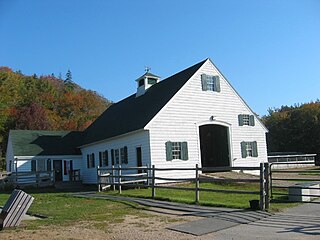
Wildwood Stables is a farm near Seal Harbor on Mount Desert Island, Maine, United States. Located in Acadia National Park, on the Park Loop Road, the farm was established in 1911. Only the original barn is now standing, after the National Park Service demolished the farm's other structures in 1958. Today, Wildwood Stables is home to several horses which pull carriages around the park's carriage trails in the spring, summer and fall months.





















